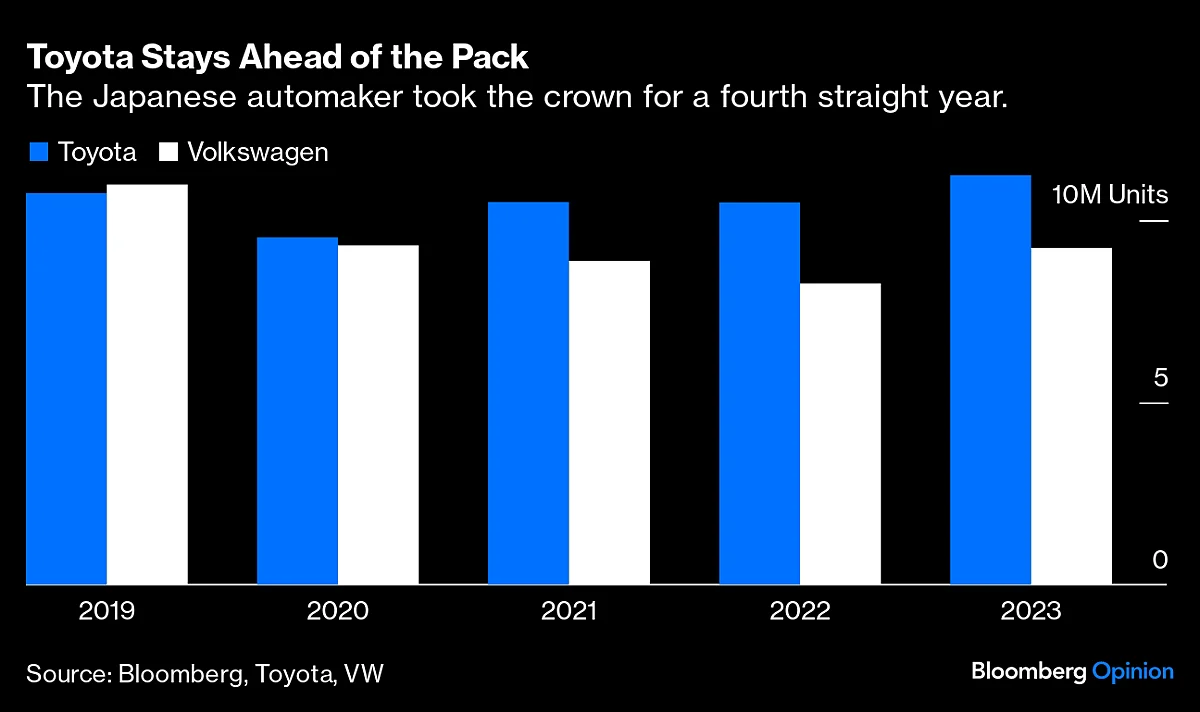The World’s Biggest Car Company Has Blurred Vision
Toyota has immediate problems on its hands, yet hasn’t outlined a clear plan to fix them — or a long-term strategy for a shift to electric vehicles.

(Bloomberg Opinion) -- Toyota Motor Corp. looks lost.
That may seem like a strange conclusion to make of a multinational giant that was just crowned the planet’s largest carmaker for a fourth straight year. But there’s reasons to be concerned: It has no clear vision for how to stay there.
Let’s start with the latest saga at the Japanese company. In December, Toyota announced that its affiliate Daihatsu Motor Co. had uncovered more than 170 irregularities in safety tests. Daihatsu’s Osaka headquarters were raided the next day by officials from the transport ministry. It suspended production, and last week recalled more than 300,000 vehicles in Japan related to these revelations of cheating.
While this was unfolding, Toyota Motor Engineering & Manufacturing recalled almost 1 million vehicles in the US — including RAV4, Lexus, Camry and Highlander models — due to possibly faulty air bags. All this comes 16 months after truck unit, Hino Motors Ltd., was ordered to fix its corporate culture after getting caught falsifying emissions and fuel-efficiency tests.
The Daihatsu scandal, which included parts supplier Toyota Industries Corp., spurred Chairman Akio Toyoda to meet Tuesday with the chairs, presidents and frontline leaders of its 17 group companies to outline the future. He’d originally planned to hold the event on Feb. 14, the birthday of founder Sakichi Toyoda, but brought it forward because of the latest developments.
Under his new plan, sovereignty will be returned to the and to the product, Toyoda told them, using the Japanese term referring to the center of production. More power will be handed to division chiefs, instead of being dictated from the top, he said.
This strategy is counter to what’s actually needed to keep the company on track. It makes sense to put specialists in charge of design and manufacturing in order to understand the market and sell more vehicles. Daihatsu produces compact cars, so someone intimately acquainted with this segment should be making its product decisions.
But a 7.2% rise in sales to 11.2 million units last year shows that designing and shipping cars isn’t Toyota’s weakness. Standards and compliance are what’s tripping up the company, and these need to be enforced from the top.

Toyota should be sharpening centralization of such an important function, instead of handing more control to individual units. And while there’s an argument to be made that many safety standards are too strict and compliance overly cumbersome, delegating decision-making back to the affiliates won’t solve that problem. Instead, Toyoda could publicly announce the hiring of more compliance staff and standards engineers, while offering a plan to use the company’s heft to lobby for regulatory change.
He did none of that this week.
Over and over, Toyoda said that he takes responsibility for the failures. But he also acknowledged that it took months before he himself knew of the irregularities that were going on inside various units including Hino and Toyota Industries. And in an exchange with the media, he revealed a distinct lack of vision for the company, noting “There is no goal” and when asked “What do you want to achieve?” he replied: “I don’t know.”
Herein lies the problem. Toyota needs a transparent and immediate plan to deal with a pattern of cheating on regulatory tests, but hasn’t enunciated one more than a year after these issues started to surface.
What’s more, the long-term blueprint for new-energy vehicles is missing. To date, Toyota’s strategy on battery and hybrid-electric models has been the right one. While Tesla Inc. and BYD Co. battle for the title of leading pure EV maker, Toyota outsells them both when you add in those that use combustion technology to power an electric motor. The company is right in believing that many customers need to ease into the EV transition, and hybrids fit the bill.
Down the road, Toyota needs to come up with a clear plan for carbon neutrality and likely regulatory curbs on the sale of combustion engines. The chairman’s strategy might get the company halfway there by allowing experts to design cars that fit customer needs. But they’re not going to embark on that path until Toyoda himself requires them to, because there’s easy money to be made today selling petroleum-powered products while the EV market is beset with price wars and shrinking margins.
“I will lead the transformation,” Toyoda told his staff and the media. His vision for that change is blurry, when it really needs to be crystal clear if Toyota is to remain on top of the world.
More From Bloomberg Opinion:
- Toyota’s Sato Needs to Truly Believe in an EV Future: Tim Culpan
- Collapsed Cakes and the Price of Perfection: Gearoid Reidy
- Toyota Halts, Investors Shrug. That's Resilience: Tim Culpan
This column does not necessarily reflect the opinion of the editorial board or Bloomberg LP and its owners.
Tim Culpan is a Bloomberg Opinion columnist covering technology in Asia. Previously, he was a technology reporter for Bloomberg News.
More stories like this are available on bloomberg.com/opinion
©2024 Bloomberg L.P.